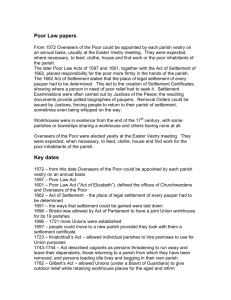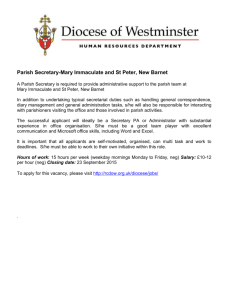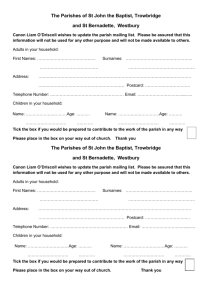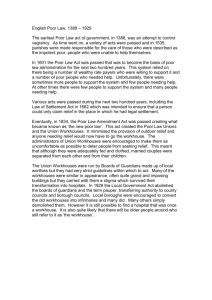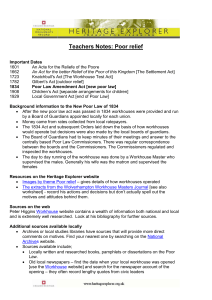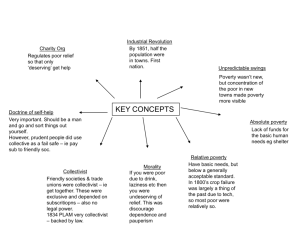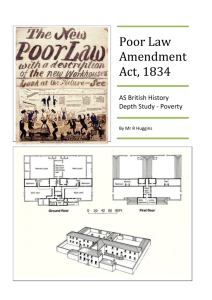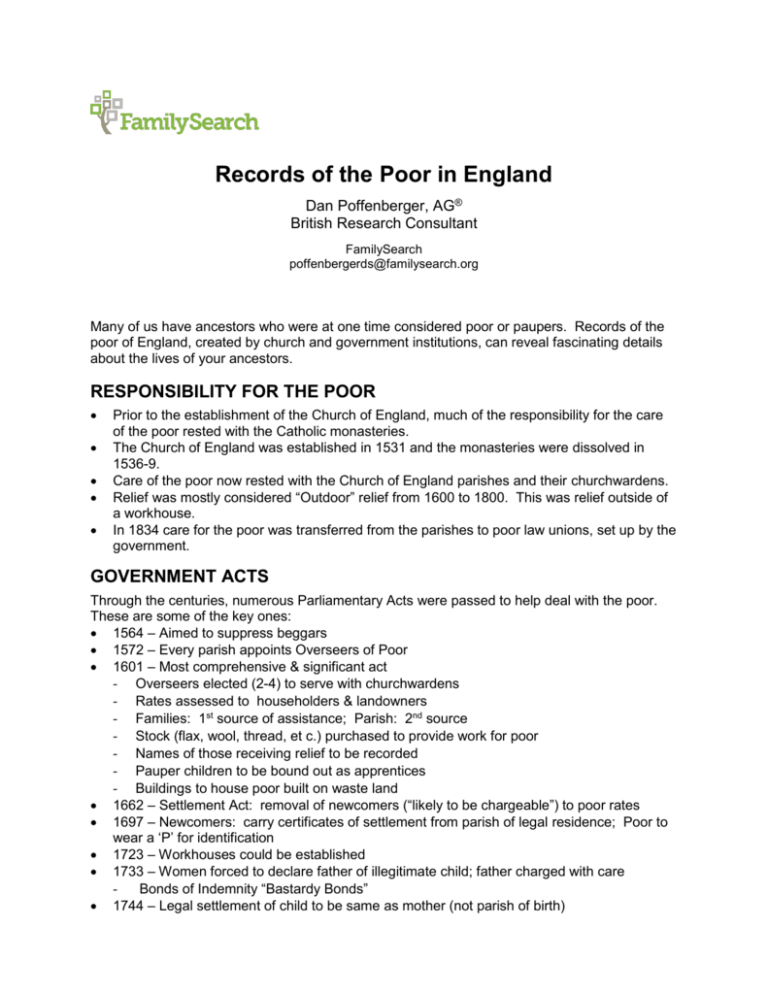
Records of the Poor in England
Dan Poffenberger, AG®
British Research Consultant
FamilySearch
poffenbergerds@familysearch.org
Many of us have ancestors who were at one time considered poor or paupers. Records of the
poor of England, created by church and government institutions, can reveal fascinating details
about the lives of your ancestors.
RESPONSIBILITY FOR THE POOR
Prior to the establishment of the Church of England, much of the responsibility for the care
of the poor rested with the Catholic monasteries.
The Church of England was established in 1531 and the monasteries were dissolved in
1536-9.
Care of the poor now rested with the Church of England parishes and their churchwardens.
Relief was mostly considered “Outdoor” relief from 1600 to 1800. This was relief outside of
a workhouse.
In 1834 care for the poor was transferred from the parishes to poor law unions, set up by the
government.
GOVERNMENT ACTS
Through the centuries, numerous Parliamentary Acts were passed to help deal with the poor.
These are some of the key ones:
1564 – Aimed to suppress beggars
1572 – Every parish appoints Overseers of Poor
1601 – Most comprehensive & significant act
- Overseers elected (2-4) to serve with churchwardens
- Rates assessed to householders & landowners
- Families: 1st source of assistance; Parish: 2nd source
- Stock (flax, wool, thread, et c.) purchased to provide work for poor
- Names of those receiving relief to be recorded
- Pauper children to be bound out as apprentices
- Buildings to house poor built on waste land
1662 – Settlement Act: removal of newcomers (“likely to be chargeable”) to poor rates
1697 – Newcomers: carry certificates of settlement from parish of legal residence; Poor to
wear a ‘P’ for identification
1723 – Workhouses could be established
1733 – Women forced to declare father of illegitimate child; father charged with care
Bonds of Indemnity “Bastardy Bonds”
1744 – Legal settlement of child to be same as mother (not parish of birth)
1782 – Parishes grouped into unions
1795 – No one could be removed from parish unless healthy and applied for relief
Some parishes used rates to assist poor to emigrate
PARISH CHEST RECORDS
Some records relating to the poor at the parish level are part of what are known as “parish
chest” records. These are:
Part of secular records of the parish
Kept in the parish chest
Types of records include:
- Minutes and accounts of Overseers
- Receipts and disbursements of funds
- Settlement and bastardy examinations
- Settlement certificates & removal orders
- Registers of apprentices & indentures
- Workhouse admissions & discharges
- Emigration lists
QUARTER SESSION RECORDS
When matters, especially criminal ones, could not be handled by the parishes, they were
referred to the county court known as Quarter Sessions – held quarterly
These include:
- Runaway fathers/apprentices
- Applications for a child’s maintenance
- Disputes over legal settlement
- Convict transportation orders
- Accounts of charities and lunatics
- Insolvent debtors
Some Quarter Sessions records have been transcribed, published, and/or indexed
THE NEW POOR LAW ACT OF 1834
Background:
- Growing unrest among poor
- Riots & attacks on poorhouses
- 1832: government appointed Royal Commission
Poor Law Unions were instituted
Each union was made up of several parishes
Boards of Guardians were appointed/elected
Each Union built a workhouse
Classes of the poor included:
- Sick, aged, and infirm
- Orphans and foundlings
- Lunatics
- Widowed and deserted wives
- School attendees
- Unemployed able-bodied
- Destitute paupers (the deserving poor)
- Vagrants (the delinquent poor)
Commission’s Philosophy:
• Devised simple way to eradicate pauperism (with minimum cost & bureaucratic
intervention)
• Compel indigent to reform (avoid living conditions in workhouse)
- conditions deliberately worse than lowest class
- have paupers feel like unwelcome guests
• Outdoor relief phased out within two years
Types of available records:
- Minutes and accounts
- Records of expenditures
- Records of admissions and discharges
- Lists of inmates
- Registers of births, baptisms, deaths and burials
- Registers of apprentices and indentures
- Registers of creed
- Records of families assisted to emigrate
- Medical records
THE UNION WORKHOUSE
1723 - The Workhouse Act: could be established by parishes if needed
Large cities (with more than one parish) allowed to build; also known as poorhouse
Intended for the sick, the elderly and orphans
Conditions in the workhouse would act as a deterrent to ‘the idle poor’; relief was only
available to those desperate enough to seek it
FINDING THE RECORDS
In Parish Chest Records
Deposited at county record offices
www.genuki.org.uk
Search FamilySearch Catalog at www.familysearch.org > Place-names Search > “Church
Records” or “Poorhouses, poor law, etc.”
www.workhouses.org.uk
Increasingly, digitized images, transcriptions and indexes are appearing online.
SUMMARY
Pre-1834: look in parish records for the poor
Post-1834: look at union workhouse records
Survival & contents of records varies widely
Always search internet for digitized records/indexes/transcripts
Need for workhouses mostly removed in 1908 with establishment of old age pensions & in
1911 with unemployment insurance
Workhouses were finally abolished in 1948
FOR FURTHER READING
Annals of the Poor by Eve McLaughlin, FHL book 942 H6mer
The Effects of the New Poor Law by Jean A. Cole, FHL book 942 P3cj
The Parish Chest by W. E. Tate, FHL book 942 K2t
Poor Law Union Records by J.S.W. Gibson, FHL book 942 P37gj – in four parts
- Each part covers the existence of records in a different region of England
Chapter 18 of Ancestral Trails by Mark D. Herber, FHL book 942 D27hm
© 2015 by Intellectual Reserve, Inc. All rights reserved. No part of this document may be reprinted or reproduced in
any form for any purpose without prior written permission.



